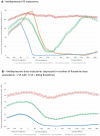Antidepressant Fill and Dose Trajectories in Pregnant Women with Depression and/or Anxiety: A Norwegian Registry Linkage Study
- PMID: 36506004
- PMCID: PMC9733444
- DOI: 10.2147/CLEP.S379370
Antidepressant Fill and Dose Trajectories in Pregnant Women with Depression and/or Anxiety: A Norwegian Registry Linkage Study
Abstract
Background: Few studies investigated longitudinal antidepressant exposure during pregnancy and included dosage in the assessment.
Methods: We conducted a nationwide, registry-linkage study in Norway using data on antidepressant prescription fills in pregnancies lasting ≥32 weeks in women with a delivery between 2009 and 2018 who had a depression/anxiety diagnosis and antidepressant fills prior to pregnancy. Information on antidepressant exposure by week (measured by filled prescriptions) and prescribed average daily dose was used in longitudinal k-means trajectory modelling for a 108-week time window from six months prior to pregnancy to one year after delivery. Factors associated with trajectory group membership were examined using multinomial logistic regression models.
Results: We included 8,460 pregnancies in 8,092 women. Four antidepressant fill trajectories were identified based on filled antidepressant prescriptions: two distinct discontinuing patterns, one at around the start of pregnancy (30.4%) and one around the end of pregnancy (33.8%); one continuing pattern (20.6%); and one interrupting pattern (15.2%). Using average usual daily dose, we identified low dose discontinuing (60.3%), medium dose reducing (20.6%) and high dose continuing (15.2%) patterns. The multinomial logistic regressions showed that the fill trajectory group membership was strongly associated with: antidepressant type and dose prior to pregnancy and co-medication prior to pregnancy, maternal age, marital status, parity, previous pregnancy loss, and pregnancy planning.
Conclusion: Longitudinal trajectory modelling revealed distinct antidepressant fill and dosage patterns in the period around pregnancy. Knowledge about factors associated with utilization trajectories might be useful for health-care personnel counselling women about antidepressant use in pregnancy.
Keywords: antidepressant fill trajectories; anxiety; depression; drug utilization; longitudinal k-means trajectory modelling; pregnancy.
© 2022 Trinh et al.
Conflict of interest statement
Kristin Palmsten receives research grants from AbbVie and GSK that are unrelated to this study. The other authors declared no conflicts of interest in relation to this work. No financial relationships with any organizations that might have an interest in the submitted work in the previous three years, no other relationships or activities that could appear to have influenced the submitted work. The funders had no role in the design and conduct of the study; the analysis and interpretation of the data; preparation; the review or approval of the manuscript.
Figures
Similar articles
-
Antidepressant and mental health care utilization in pregnant women with depression and/or anxiety: An interrupted time-series analysis.J Affect Disord. 2022 Jul 1;308:458-465. doi: 10.1016/j.jad.2022.04.101. Epub 2022 Apr 21. J Affect Disord. 2022. PMID: 35461816
-
Longitudinal trajectories of antidepressant use in pregnancy and the postnatal period.Arch Womens Ment Health. 2018 Aug;21(4):411-419. doi: 10.1007/s00737-018-0809-2. Epub 2018 Jan 16. Arch Womens Ment Health. 2018. PMID: 29340802 Free PMC article.
-
Timing of Antidepressant Discontinuation During Pregnancy and Postpartum Psychiatric Outcomes in Denmark and Norway.JAMA Psychiatry. 2023 May 1;80(5):441-450. doi: 10.1001/jamapsychiatry.2023.0041. JAMA Psychiatry. 2023. PMID: 36884236 Free PMC article.
-
Use of interrupted time-series analysis to characterise antibiotic prescription fills across pregnancy: a Norwegian nationwide cohort study.BMJ Open. 2021 Dec 8;11(12):e050569. doi: 10.1136/bmjopen-2021-050569. BMJ Open. 2021. PMID: 34880014 Free PMC article.
-
Antiemetic Prescription Fills in Pregnancy: A Drug Utilization Study Among 762,437 Pregnancies in Norway.Clin Epidemiol. 2021 Feb 26;13:161-174. doi: 10.2147/CLEP.S287892. eCollection 2021. Clin Epidemiol. 2021. PMID: 33664595 Free PMC article.
Cited by
-
Real-World Data Insights into Antidepressant Prescription and Adherence During Pregnancy in Catalonia (Spain).Drug Saf. 2025 Jul 9. doi: 10.1007/s40264-025-01576-z. Online ahead of print. Drug Saf. 2025. PMID: 40632487
-
Antidepressant use during pregnancy and birth outcomes: analysis of electronic health data from the UK, Norway, and Sweden.medRxiv [Preprint]. 2024 Oct 30:2024.10.30.24316340. doi: 10.1101/2024.10.30.24316340. medRxiv. 2024. PMID: 39574855 Free PMC article. Preprint.
-
Switching pattern and dose adjustment of antidepressants before and during pregnancy.Arch Womens Ment Health. 2023 Oct;26(5):685-696. doi: 10.1007/s00737-023-01355-8. Epub 2023 Aug 5. Arch Womens Ment Health. 2023. PMID: 37542677 Free PMC article.
-
Partner support for women's antidepressant treatment and its association with depressive symptoms in pregnant women, mothers, and women planning pregnancy.Arch Womens Ment Health. 2024 Aug;27(4):557-566. doi: 10.1007/s00737-024-01435-3. Epub 2024 Feb 2. Arch Womens Ment Health. 2024. PMID: 38305896 Free PMC article.



